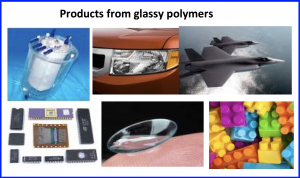Polymeric materials are one of the most important engineering materials with uses that span automotive, aerospace, electronic packaging, medical devices and a variety of consumer goods. One of the most important classes of polymers are glasses, which include the matrix resin in aerospace composites, contact lens, automotive head/tail lights and many other products. An understanding of the glassy state is one of the outstanding problems in condensed matter physics, where there is no fundamental model of the glass even though there has been research on the glassy state for nearly 100 years. 
The Caruthers’ group has developed models of how glassy polymers deform. The key idea in these models is that the mobility increases with deformation. One of feature of the deformation behavior of glassy polymers that has been difficult to model is the post-yield stress softening, i.e. the relaxation of stress following yield. The Caruthers’ Group developed a Stochastic Constitutive Model (SCM) that for the first time has been able to naturally predict post-yield stress softening and how it increases with annealing time in the glassy state. The SCM makes a different assumption than is traditionally employed in continuum mechanics. Instead of first averaging quantities like stress, density, etc. and then looking for relationships between these average quantities, the SCM postulates a simple relationship between the fluctuating stress and entropy, where the macroscopic behavior is then determined by averaging many of these fluctuating relationships. A key consequence of the SCM is the shape of the effective relaxation spectra changes with time during the deformation, which is consistent with experimental observation.
The key signature of glassy behavior is the spectacular decrease in mobility as the temperature is lowered from high temperatures towards the glass transition temperature, where the material then becomes a solid.  This decrease in mobility can be ten orders-of-magnitude greater than that anticipated from the traditional Arrhenian temperature dependence observed at high temperatures. Current research is focusing on connecting this extraordinary decrease in mobility with changes in the thermodynamic state of the material as it is cooled.
This decrease in mobility can be ten orders-of-magnitude greater than that anticipated from the traditional Arrhenian temperature dependence observed at high temperatures. Current research is focusing on connecting this extraordinary decrease in mobility with changes in the thermodynamic state of the material as it is cooled.
Selected References:
1. G.A. Medevedev and J.M. Caruthers, “Development of a Stochastic Constitutive Model for Prediction of Post-Yield Softening in Glassy Polymers,” Journal of Rheology, 57(3), 949-1002 (2013).
2. G.A. Medvedev and J.M. Caruthers, “Predictions of Volume Relaxation in Glass Forming Materials Using a Stochastic Constitutive Model,” Macromolecules, 48(3) 788-800 (2015).
3. J.M. Caruthers and G.A. Medvedev, ‘Thermo-Mechanical Signatures of Glassy Polymers,’ in ‘Polymer Glasses’, edited by C.B. Roth, Taylor and Francis, London, 107-178 (2016).
4. G.A. Medvedev and J.M. Caruthers, ‘A Comparison of Constitutive Descriptions of the Thermo-Mechanical Behavior of Polymeric Glasses,’ in ‘Polymer Glasses’, edited by C.B. Roth, Taylor and Francis, London, 453-538 (2016).